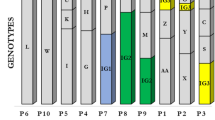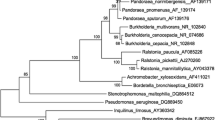Abstract
Genome fingerprinting by field inversion gel electrophoresis (FIGE) was utilized to typify 129 isolates of Pseudomonas cepacia (Pc) from 59 patients with cystic fibrosis (CF) and from environmental cultures in the CF ward. The aim of this study was to assess whether a segregation policy avoided colonization of CF patients by nosocomial strains and contamination of the environment by colonized individuals, whether or not an ‘epidemic strain’ was present in the ward and whether cross-colonization occurred in CF individuals subjected to prolonged close contact. The Pc strains of each patient remained unchanged over time; 78% of the genome fingerprintings (GFP) were individual, whereas the others gave rise to 9 GFP groups. A spirometer was probably contaminated by a newly colonized patient. Adequate sanitary measures and avoidance of excessive promiscuity are helpful for limiting but are unable to eliminate Pc transmission in the CF ward. Direct or indirect transmission, however seems, more frequent in CF patients in contacts outside the hospital.
Similar content being viewed by others
References
Anderson DJ, Khuns JS, Vasil ML, Gerding DL, Janoff EN. DNA fingerprinting by pulsed field gel electrophoresis and ribotyping to distinguish Pseudomonas cepacia isolates from a nosocomial outbreak. J Clin Microb 1991; 29: 648–649.
Bingen EH, Weber M, Derelle J, Brahimi N, Lambert-Zechovsky NY, Vidailhet M, Navarro J, Elion J. Arbitrarily primed polymerase chain reaction as a rapid method to differentiate crossed from independent Pseudomonas cepacia infections in cystic fibrosis patients. J Clin Microb 1993; 31: 2589–2593.
Gilardi GL. Pseudomonas and related genera. In: Balows A, Hausler WJ, Herrmann KL, Isenberg HD, Shadomy HJ. Manual of Clinical Microbiology, 5th ed. 1991. American Society for Microbiology, Washington, DC.
Grothues D, Koopmann U, von der Hardt H, Tuemmler B. Genome fingerprinting of Pseudomonas aeruginosa indicates colonisation of cystic fibrosis siblings with closely related strains. J Clin Microb 1988; 26: 1973–1977.
Kostman JR, Edlind TD, LiPuma JJ, Stull TL. Molecular epidemiology of Pseudomonas cepacia determined by polymerase chain reaction ribotyping. J Clin Microb 1992; 30: 2084–2087.
Li Puma JJ, Dasen SE, Nielson DW, Stern RC, Stull TL. Person to person transmission of Pseudomonas cepacia between patients with cystic fibrosis. Lancet 1990; 1: 1094–1095.
McClelland M, Jones R, Patel Y, Nelson M. Restriction endonucleases for pulsed field mapping of bacterial genomes. Nucleic Acids Research 1987; 15: 5985–6005.
Ojeniyi B, Steen Petersen U, Hoiby N. Comparison of genome fingerprinting with conventional typing methods used on polyagglutinable Pseudomonas aeruginosa isolates from cystic fibrosis patients. APMIS 1993; 101: 168–175.
Orkin Lewin L, Byard PJ, Davis PB. Effect of Pseudomonas cepacia colonisation on survival and pulmonary function of cystic fibrosis patients. J Clin Epidemiol 1990; 43: 125–131.
Palleroni NJ. Pseudomonaceae. In: Krieg NR, Holt JG. Bergey's Manual of Systematic Bacteriology, Vol 1. 1984; Williams and Wilkins, Baltimore/London.
Simmonds EJ, Conway SP, Ghoneim ATM, Ross H, Littlewood JM. Pseudomonas cepacia: A new pathogen in patients with cystic fibrosis referred to a large centre in the United Kingdom. Arch Dis in Child 1990; 65: 874–877.
Sruelens MJ, Schwam V, Deplano A, Baran D. Genome macrorestrition analysis of diversity and variability of Pseudomonas aeruginosa strains infecting cystic fibrosis patients. J Clin Microb 1993; 31: 2320–2326.
Tablan OC, Martone WJ, Doershuk CF, Stern RC, Thomassen MJ, Klinger JD, White JW, Carson LA. Colonisation of the respiratory tract with Pseudomonas cepacia in cystic fibrosis. Risk factors and outcomes. Chest 1987; 91: 527–532.
Taylor RFH, Dalla Costa L, Kaufmann ME, Pitt TC, Hodson ME. Pseudomonas cepacia pulmonary infection in adults with cystic fibrosis: is nosocomial acquisition occurring? J Hosp Infect 1992; 21: 199–204.
Tomashefski JF, Thomassen MJ, Bruce MC, Goldberg HI, Konstan MW, Stern RC. Pseudomonas cepacia associated pneumonia in cystic fibrosis. Arch Pathol Lab Med 1988; 112: 166–172.
Thomassen MJ, Demko CA, Klinger JD, Stern RC. Pseudomonas cepacia colonisation among patients with cystic fibrosis. Am Rev Respir Dis 1985; 131: 791–796.
Thomassen MJ, Demko CA, Doershuk CF, Stern RC, Klinger JD. Pseudomonas cepacia: decrease in colonisation in patients with cystic fibrosis. Am Rev Resp. Dis 1986; 143: 669–671.
Welsh J, McClelland M. Fingerprinting genomes using PCR with arbitrary primers. Nucleic Acids Res 1990; 18: 7213–7218.
Williams JGK, Kubelik AR, Livak KJ, Rafalski JA, Tingey SV. DNA polymorphism amplified by arbitrary primers are useful as genetic markers. Nucleic Acids Res 1990; 18: 6531–6535.
Author information
Authors and Affiliations
Rights and permissions
About this article
Cite this article
Amalfitano, G., Tonolli, E., Favari, F. et al. Field inversion gel electrophoresis on Pseudomonas cepacia strains isolated from cystic fibrosis patients. Eur J Epidemiol 12, 149–153 (1996). https://doi.org/10.1007/BF00145500
Accepted:
Issue Date:
DOI: https://doi.org/10.1007/BF00145500




